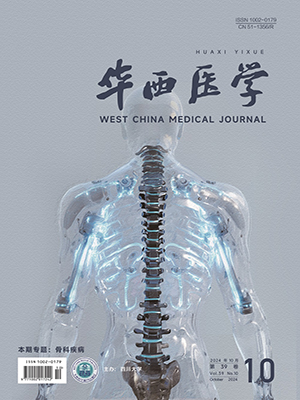目的 研究同型半胱氨酸转硫途径、维生素B6及内源性硫化氢在慢性阻塞性肺疾病急性加重期(AECOPD)中的作用。 方法 2010年2月-4月间筛选AECOPD患者16例和健康志愿者(对照组)13例,测定AECOPD患者加重期、缓解期及对照组的肺功能、血清硫化氢(H2S)、丙二醛(MDA)、叶酸、维生素B12、C反应蛋白、白介素6、血浆同型半胱氨酸、胱硫醚、半胱氨酸和维生素B6的浓度。计算半胱氨酸转化率(半胱氨酸浓度/胱硫醚浓度)与胱硫醚转化率(胱硫醚浓度/同型半胱氨酸浓度)参与分析。 结果 ① 加重期血清MDA水平[(7.3 ± 5.1)nmol/L ]比缓解期[(3.0 ± 1.4)nmol/L ]和对照组[(3.0 ± 2.2)nmol/L ]均升高(P<0.01);血清MDA水平与第1秒用力呼气容积/用力肺活量(FEV1/FVC)、第1秒用力呼气容积占预计值百分比(FEV1%预计值)呈负相关。② 加重期血清H2S水平与血浆维生素B6水平较缓解期与对照组降低(P<0.01);缓解期血清H2S水平[(47.2 ±5.1) μmol/L ]高于对照组[(38.8 ± 2.1) μmol/L ],P<0.01;血清H2S水平、血浆维生素B6水平均与FEV1%预计值呈正相关(r=0.651、0.680,P<0.01),均与血清MDA水平呈负相关(r=-0.334、-0.448,P<0.05)。③ 加重期半胱氨酸转化率(3.97 ± 2.41)低于缓解期(5.92 ± 2.18)与对照组(6.14 ± 3.15)差异有统计学意义(P<0.05);而胱硫醚转化率则相反。④ 叶酸与维生素B12水平各组间均无差异。 结论 提高AECOPD患者维生素B6及H2S浓度可能能促使AECOPD患者向稳定状态转归,减轻氧化应激损伤。维生素B6与H2S可能成为AECOPD患者的一个新的治疗点。
Objective To study the roles of homocysteine (Hcy) transsulfuration pathway, Vitamin B6 and endogenous hydrogen sulfide in treating patients with acute exacerbation of chronic obstructive pulmonary disease (AECOPD). Methods Sixteen AECOPD patients and 13 healthy controls (Control group) from February to April 2010 were recruited in this study. Lung function, serum hydrogen sulfide (H2S), malondialdehyde (MDA), folate, vitamin B12, C-reactive protein (CRP), interleukin-6 (IL-6), Hcy, cystathionine, cystein (Cys) and vitamin B6 were all measured for all the patients in the acute exacerbation period and alleviation period and healthy controls. The conversion rate of Cys (expressed as Cys/cystathionine) and the conversion rate of cystathionine (expressed as cystathionine/Hcy) were calculated for analysis. Results Serum MDA level for patients in the acute exacerbation period (AE period) [(7.3 ± 5.1) nmol/L] was significantly higher than that in the alleviation period [(3.0 ± 1.4) nmol/L] and in the healthy controls [(3.0 ± 2.2) nmol/L] (P < 0.01). Serum MDA level was negatively correlated with percentage of FEV1 in predicted FEV1 (FEV1% pred) and FEV1/FVC. Serum H2S level and plasma vitamin B6 level for patients in the AE period were significantly lower than those in the alleviation period and in the healthy controls (P < 0.01), and serum H2S level was significantly higher in the alleviation period [(47.2 ± 5.1) μmol/L] than in the controls [(38.8 ± 2.1) μmol/L] (P < 0.01). Both serum H2S and plasma vitamin B6 levels were correlated positively with FEV1% pred for patients in the AE period and healthy controls (r=0.651, 0.680; P < 0.01), but negatively correlated with serum MDA level (r=-0.334, -0.448; P < 0.05). The conversion rate of Cys for patients in the AE period (3.97 ± 2.41) was significantly lower than that in the alleviation period (5.92 ± 2.18) and the control group (6.14 ± 3.15) (P < 0.05), but the conversion rate of cystathionine was just the opposite (P < 0.05). There were no significant differences in the levels of serum folate and vitamin B12 among the three groups. Conclusion Raising the Vitamin B6 and H2S level may facilitate stabilizing of conditions in patients with AECOPD and reduce oxidative stress. Therefore, it may become a new treatment method for AECOPD.
Citation: ZHAO Li,WEN Fuqiang,ZUO Qiunan,WANG Ye,CHEN Lei,WANG Tao. Research on the Roles of Homocysteine Transsulfuration Pathway, Vitamin B6 and Endogenous Hydrogen Sulfide in Treating Patients with Acute Exacerbation of Chronic Obstructive Pulmonary Disease. West China Medical Journal, 2012, 27(2): 213-217. doi: CNKI: 51-1356/R.20120214.1341.014 Copy
-
Previous Article
体外血栓模型设计及标准化探讨 -
Next Article
Study on the Effect of Oral Administration of Marine Collagen Peptides on Epidermal Water and Chloasma




